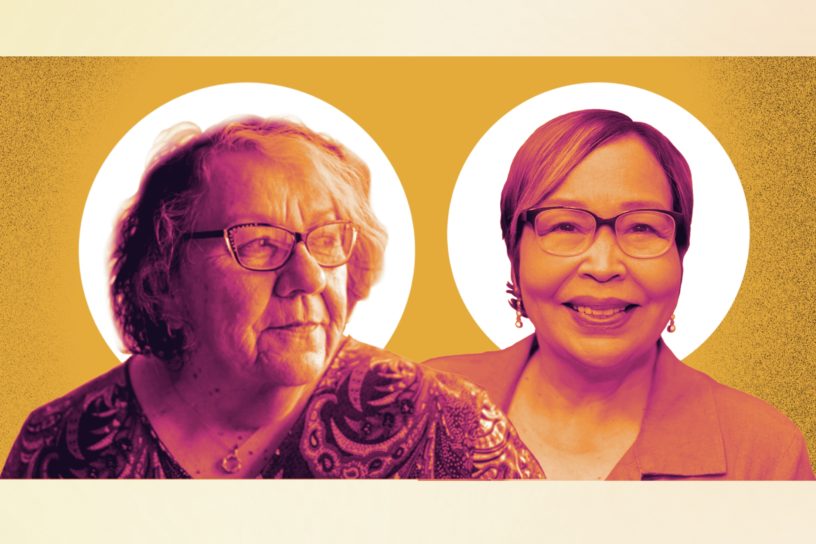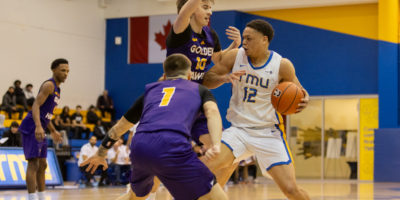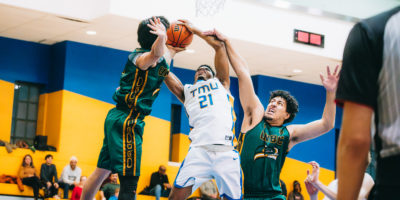Disclaimer: Sommerly Grimaldi-Ertl is the president of the Indigenous Student Association
By Sommerly Grimaldi-Ertl
The objective of truth and reconciliation extends beyond the one-day national recognition each year on Sept. 30. Instead, it’s a lifelong commitment for many who have dedicated their lives to Indigenous justice, resilience and determination. The same holds true for various community members at Toronto Metropolitan University (TMU).
Some, like Monica McKay, exercise that commitment by jump-starting initiatives.
McKay has been the director and founder of Gdoo-maawnjidimi Mompii “We Gather Here” Indigenous Student Services (GMISS) since 1993 when she first joined the school as a mature student in the social work program. She was thousands of kilometres away from her home community, Laxgalts’ap (Greenville), B.C., where she is a proud member of the Nisga’a Nation and belongs to the House of Heewa’a.
McKay’s journey as a student began with isolation, leaving her community and feeling invisible after moving away from her family.
“I blink and I can still see myself walking down the hallway and going ‘I just feel so invisible like I’m the only person here,’” recalled McKay.
Despite feeling isolated and invisible upon her arrival at TMU, she persevered by using her experiences as an Indigenous student as a catalyst to lay the foundation for Indigenous Initiatives at the university.
“Students are always at the centre of our circle”
McKay sought out other Indigenous students with some coffee and a plan.
“I hoped to find a sense of belonging in a space that, at the time, didn’t have any services for Indigenous students and faculty,” she said.
McKay began posting flyers about monthly Indigenous student meetups and hoped by doing so she would connect with others who may be in the same position as herself. She didn’t think she could make it through university without a sense of community.
“I [felt] like I’m the only Indigenous person on this campus,” said McKay. “I can’t be. You know, it [was] 1993, there must be other students.”
“At the October gathering, nobody showed…but another person came in November, and another person came in December, and I remember them coming and coming,” she said.
By the end of that first year, McKay found six other Indigenous students to begin building a community with—a modest number compared to now approximately 400 students according to her—but enough to hold onto hope for a bigger future for the Indigenous community at TMU.
Now, 30 years later, McKay’s vision for Indigenous excellence has become a pan-wide university vision which ensures access to specialized services that “strike a balance between academic excellence and traditional teachings and culture.”
“I can go around, I can go over, I can go under, but I won’t stand still”
With the expansion of Indigenous Student Services throughout the years, it provides students with resources and living space for the community to gather.
Aleshia Kremer, a third-year biology student, described her challenges adapting to a drastic move from Teslin, Yukon.
“Moving to a place where no one knows me and being so far from nature—I mean, there’s trees—but it does not compare at all to home,” she said.
“I didn’t access any of the services and it’s made a noticeable difference in the last year; having access to this space and meeting other Indigenous students,” Kremer continued. “Otherwise, I didn’t find there was another way to make community at school.”
Among other students, Kremer noted that without the Indigenous Student Services’ resources, she probably would no longer be attending TMU.
“I struggled a lot moving to the city just because my town is so small, and it’s hard to explain it there, but if someone’s not in a small town, they wouldn’t understand,” she said. “Indigenous services are like a little glimpse of home.”
Wyatt Wichert, a third-year social work student, said Indigenous Student Services played a critical role in his life.
“Being able to connect with the Indigenous community here has helped me reclaim culture. I wouldn’t be at TMU if I didn’t have the community,” he said. “I went through some hardships and having the community behind me [to] support me through it was exactly what kept me in school.”
McKay began her journey with just a one-person office and a vision. Today, everyone at Indigenous Student Services continues serving the community and makes meaningful impacts on countless students in their academic journeys.
Looking back on some challenges, McKay recalled it wasn’t easy to form Indigenous Student Services with some resistance over the years.
“Places like this hang onto ideas of colonial structures and were made for people who had everything ready in their lives to be able to do this. And for us, it’s a big chance,” she said. “What I’ve learned is when something comes to a standstill, I remind myself that I don’t need to stand there.”
“I can go around, I can go over, I can go under, but I won’t stand still,” said McKay.
“Indigenous services are like a little glimpse of home”
Despite progress, there is more to the work to be done for the Indigenous community, both on and off campus.
McKay explained that some people go about their lives without analyzing structural barriers that have no negative impact on them, saying “those of us that are impacted by racist policies wanted to change right now.”
She used a trauma-informed framework in building GMISS and continues to in her work across campus. As McKay said, for relationship building to occur, people need to “understand you can’t use a transactional model.” When this is understood by both parties, harm can be avoided.
In regards to breakthroughs for change at the university, McKay said “it takes a person in a senior leadership position to make your work a priority and that happened in 2006.”
She said former TMU president, Sheldon Levy, was the first to host a roundtable on Indigenous education. He also made a structural change and created the Provost’s position overseeing “Aboriginal education” with the creation of the Indigenous Education Council in 2010.
“It really shook things up here,” said McKay.
“I hoped to find a sense of belonging in a space that, at the time, didn’t have any services for Indigenous students and faculty”
Truth and reconciliation is an ongoing conversation between Indigenous students, staff and allies at the university. Still, McKay said TMU is lucky to have documents in place for guidance in critical changes.
“The beginning point is always to go back to those two important documents. TMU’s Truth and Reconciliation Report and the Standing Strong Report,” she said.
“Although you can’t think of those in isolation from the larger Truth and Reconciliation Report or the Murdered and Missing Women’s Commission Report because both of those are very clear in terms of what they’re asking from post-secondary institutions,” McKay added about the two documents.
In light of the name change from Ryerson University to TMU in 2022—one of 22 recommendations from the Standing Strong Task Force—the work for reconciliation is still ongoing. The force is made up of 14 university members, including students, faculty, staff and alumni responding to the history and legacy of Egerton Ryerson who was considered to be “an architect of the residential school system.”
“We’ve had one of the largest pieces which people didn’t think would ever happen—a name change—but all of the other recommendations are just as important,” said McKay.
Campus Elder (Ke Shay Hayo) Joanne Okimawininew Dallaire (Shadow Hawk Woman) added to McKay’s point saying, “It’s important the Standing Strong Task Force wasn’t about reaching consensus, it was about reaching understanding.”
Elder Dallaire joined Indigenous Student Services in 2001 as a traditional counsellor. Now she acts as the chair for Indigenous Education while being appointed the role of Elder and Senior Advisor in Truth and Reconciliation in 2019.
“I sit on committees to ensure the concepts of Indigenous ways of knowing and being are incorporated in education and I directly advise the president,” explained Elder Dallaire.
Elder Dellaire’s contributions extend beyond senior leadership advisement as she takes on the entirety of what it means to be a community elder. She said her door is always open for students, faculty and staff for guidance and traditional knowledge.
As some recommendations from the Standing Strong Task Force have yet to be completed, discussions regarding truth and reconciliation are far from over at TMU. Elder Dallaire shared that as a lifelong teacher, she’s often answering questions regarding relationship building.
“We’re a very small population of people and a common question is ‘why can’t you just get over it?’ Getting over it would say that’s in the past but it isn’t,” said Elder Dallaire. “These are treaties that we live now. We are still drawing up treaties, so this is not a past thing. This is a current, flowing, growing way of dealing with each other.”
McKay shared insights to relationship models and said institutions like TMU exist because of its students.
“I’ve come to realize how important having allies are…they’re able to ensure that we’re represented in conversation that we haven’t been invited into,” she said. “Students are always at the centre of our circle.”
Many students said that reconciliation is a challenging topic at TMU that involves them taking on different roles to ensure change.
Brooke Filsinger, advisor to the dean in Indigenous education in the faculty of science and a PhD candidate in environmental applied science and management, said voices of Indigenous students must be centred to carry out said change.
“Indigenous students represent the largest group of Indigenous folks on campus, far outnumbering Indigenous faculty and staff. We are also the group of individuals most impacted by many well-intentioned initiatives,” said Filsinger. “Yet, many of these initiatives and other decisions are being made on our behalf without consulting us directly.”
“It’s important the Standing Strong Task Force wasn’t about reaching consensus, it was about reaching understanding”
Relationship building between the Indigenous and non-Indigenous community is imperative towards cultivating meaningful change, as Filsinger said, “It takes time to be in relationship with Indigenous students, but the insights gained from engaging with us are invaluable.”
Kremer said she feels as though the university isn’t actively doing their share.
“I also find it hard, a lot of the initiatives done have been done reactively, instead of proactively,” she said. “It took people protesting the [Ryerson] name for it to become a change, instead of the university itself looking at its history and noticing that maybe it should have been changed a while ago.”
The Eyeopener reached out to the university for comment but they did not respond in time for publication.
Indigenous students at TMU are seen to take on many responsibilities.
“The most surprising [thing] for me working at TMU with students was the pressure that students put themselves under to come to the university,” said Elder Dellaire. “I believe that the university can [also] step up. It’s not the staff and the students that need to do the heavy lifting.”
Filsinger said she feels a sense of responsibility to represent and advocate for Indigenous student communities.
“Indigenous students are frequently asked to take on roles that aren’t generally asked of the broader student body. We are called upon to be leaders, advisors, trailblazers, cultural interpreters and mentors, to name a few,” said Filsinger. “It can be exhausting. But I also recognize that we are here because of those who came before and did the work to create spaces for us.”
Looking towards the future, Elder Dellaire said everyone has a responsibility to learn and teach each other. When people take this approach modeling the two row wampum belt—where there are two paths of being—they can grow together.
When imagining a vision for Indigenous initiatives at TMU, Elder Dellaire said she thinks it is important for everyone, both Indigenous and non-Indigenous, to “move away from the victimized identification into the thriver.”
Elder Dellaire continued saying, “As we do that, we give strength to other people who need to maybe push the envelope in their own life, or from other communities to push the envelope for their own recognition.”











Leave a Reply